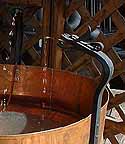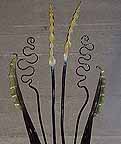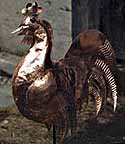"Celts at the
Gate - Spears and Shield"
Revised Images, January 2008
In early summer of 2006, I had an the chance to
place a couple of larger pieces at the wonderful St˙ll
Gallery in upscale Elora, Ontario. I had
known two of the co-owners, Elsa Mann and Paul
Kane (of Night & Day Studio) for some
time. St˙ll (pronounced 'style') is in
a converted limestone mill right at the bridge in
central Elora. A great location, and even better,
2006 marked the opening of a sculpture garden
along the banks of the river. Ideal for some of my
larger pieces, including two panels of my 'Paris
Metro' Arbour.
See description
below for more details on the original design
inspiration from the Celtic Iron Age...
An upper deck required a gate, both for security
and just plain looks. I reworked 'Celts at the
Gate - Spears and Shield' for this purpose. (See
the original description below.) First a
matching narrow companion panel was created, so
the combination would fit the larger space. The
same kind of split end channel was used for the
uprights, with similar sweeping curves and
spirals as the body of the design. Second, the
original hinges were moved to suit the new
installation, with much heavier hinge plates
used. Third, both pieces received a new more
decorative paint finish. The original blue
was both too stark and too bright. A spray coat
of very dark blue was applied over this base
colour, with a touch of green highlights on some
of the curves. The end result looks almost black
until you get right close to the gate - a far
more subtle use of colour. The original bronze
sheet with glass disk was removed, as in the end
this was a great concept that did not work
as well in practice as I would have liked.
In this configuration, 'Spears
and Shield' was featured in 'Ironwork Today,
volume 2'
Details :
Total Width : 51" / 130 cm
Main Panel : 36" / 92 cm
Side Panel 15" / 32 cm
When St˙ll was closed (the building sold
from underneath them) 'Spear and Shield' was
installed on the new upper deck at Wareham.
|







